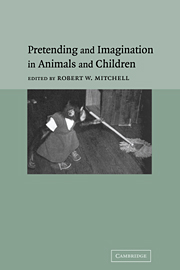Book contents
- Frontmatter
- Contents
- List of contributors
- Foreword by Sue Taylor Parker
- Preface and acknowledgments
- I Historical, developmental, and comparative overviews
- II Pretense and imagination in children
- III Pretense and imagination in primates
- 13 Pretending in monkeys
- 14 Pretending primates: play and simulation in the evolution of primate societies
- 15 Representational capacities for pretense with scale models and photographs in chimpanzees (Pan troglodytes)
- 16 Pretending in free-ranging rehabilitant orangutans
- 17 Seeing with the mind's eye: eye-covering play in orangutans and Japanese macaques
- 18 Possible precursors of pretend play in nonpretend actions of captive gorillas (Gorilla gorilla)
- 19 Pretending culture: social and cognitive features of pretense in apes and humans
- 20 Empathy in a bonobo
- 21 Pretend play in a signing gorilla
- IV Prospects
- References
- Author Index
- Subject Index
17 - Seeing with the mind's eye: eye-covering play in orangutans and Japanese macaques
Published online by Cambridge University Press: 13 August 2009
- Frontmatter
- Contents
- List of contributors
- Foreword by Sue Taylor Parker
- Preface and acknowledgments
- I Historical, developmental, and comparative overviews
- II Pretense and imagination in children
- III Pretense and imagination in primates
- 13 Pretending in monkeys
- 14 Pretending primates: play and simulation in the evolution of primate societies
- 15 Representational capacities for pretense with scale models and photographs in chimpanzees (Pan troglodytes)
- 16 Pretending in free-ranging rehabilitant orangutans
- 17 Seeing with the mind's eye: eye-covering play in orangutans and Japanese macaques
- 18 Possible precursors of pretend play in nonpretend actions of captive gorillas (Gorilla gorilla)
- 19 Pretending culture: social and cognitive features of pretense in apes and humans
- 20 Empathy in a bonobo
- 21 Pretend play in a signing gorilla
- IV Prospects
- References
- Author Index
- Subject Index
Summary
Introduction
Eye-covering play, deliberately closing or covering one's eyes during a play sequence, has been documented in various nonhuman primates. Some observers have suggested that eye-covering play involves pretending – acting as if one can't see, doesn't exist, or exists in some altered form (Cunningham, 1921; Hahn, 1982; de Waal, 1986b, 1989). Only one systematic study has been made of eye-covering play in nonhuman primates (Thierry, 1984) and no systematic attempts have been made to investigate the cognitive processes involved. We systematically studied eye-covering play in captive orangutans (Pongo pygmaeus) and Japanese macaques (Macaca fuscata) with the aim of assessing its cognitive implications in relation to pretending and imagination.
Cunningham (1921) was perhaps the first to describe eye-covering play in a nonhuman primate – in an immature lowland gorilla (Gorilla gorilla) who would shut his eyes tightly then run around knocking into furniture, which was interpreted as pretending to be blind. Eye-covering play has since been reported in all the great apes. Their play often takes the form of stumbling or groping about while “blind” (Hoyt, 1941; Harrisson, 1961, 1962; Lang, 1963; Gautier-Hion, 1971b; Goodall, 1971; Rensch, 1972; de Waal, 1986b, 1989). Occasionally they use objects to cover their eyes (Harrisson, 1962; Lang, 1963; Goodall, 1971; Rensch, 1972; de Waal, 1986b, 1989) and eye-covering play sometimes occurs as a social game (Hoyt, 1941; Harrisson, 1962).
- Type
- Chapter
- Information
- Pretending and Imagination in Animals and Children , pp. 241 - 254Publisher: Cambridge University PressPrint publication year: 2002



